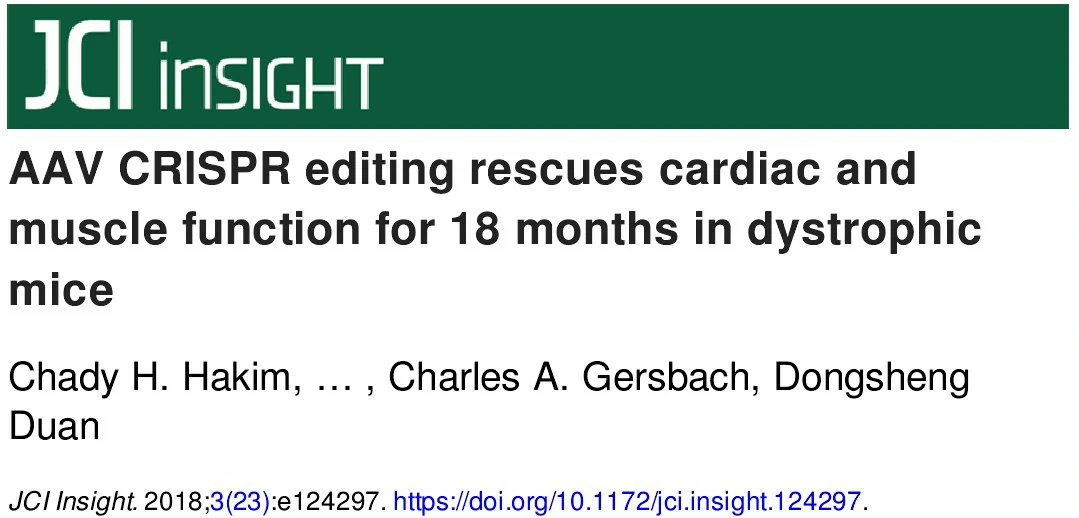AAV CRISPR editing rescues cardiac and muscle function for 18 months in dystrophic mice
Introduction: Duchenne muscular dystrophy (DMD), caused by out-of-frame mutations of dystrophin gene, is a progressive degenerative disease resulting in cardiac and smooth muscle dysfunction in approximately 250–300,000 boys and young men worldwide. Previous studies showed that AAV-delivered CRISPR gene editing tools can reframe the mutated dystrophin gene and restore dystrophin expression in vitro and in vivo for short time. However, whether a one-time systemic AAV CRISPR therapy can mediate long-term dystrophin restoration and disease amelioration is still not known. Recently, one research group at the University of Missouri has addressed this critical question. They found that gRNA vector depletion acted as a key barrier for long-term AAV CRISPR therapy and an addition of gRNA vector dose is enough to restore sustained dystrophin expression and rescue heart and skeletal muscle function in mdx mice, a widely used DMD model.
On December 6th, the result was published in the journal of JCI insight, titled by " AAV CRISPR editing rescues cardiac and muscle function for 18 months in dystrophic mice ". The study reveals that loss of the gRNA vector may restrain long-term systemic AAV CRISPR therapy of DMD disease in vivo and an addition of gRNA vector injection would improve long-term therapy results. Considering the limited AAV cargo capacity of approximately 4.7–5 kb, the authors utilized Staphylococcus aureus Cas9 (SaCas9), which is 25% smaller than SpCas9, efficient and broadly targeting. They injected AAV9 CRISPR vectors into 6-week-old mdx mice via tail vein, and then detected expression of dystrophin and cardiac and smooth muscle function at 18 months of age. Firstly, they found that 12 months after AAV9 CRISPR vectors delivery, no therapeutic effects have been detected between treated and untreated mdx mice, and the off-target effects has been excluded. To figure out, they quantified the expression levels of SaCas9 and gRNA, discovering that gRNA vector genome was significantly depleted compared with that of the Cas9 vector in same tissues. Then, the study was repeated by increasing the gRNA vectors injection dose, leading to long-lasting dystrophin restoration and function improvement in striated muscles throughout the body. What’s more, an optimization of gRNA vector dose failed to get further restoration of dystrophin. In brief, this paper proposes a long-time gene therapy mediated by AAV CRISPR vectors to treat Duchenne muscular dystrophy caused by dystrophin gene mutations, suggesting that AAV CRISPR gene editing tools are suitable for long-term gene therapy in vivo on the condition of no loss of gRNA vectors.
References
1. AAV CRISPR editing rescues cardiac and muscle function for 18 months in dystrophic mice
2. Muscle-specific CRISPR/Cas9 dystrophin gene editing ameliorates pathophysiology in a mouse model for Duchenne muscular dystrophy






